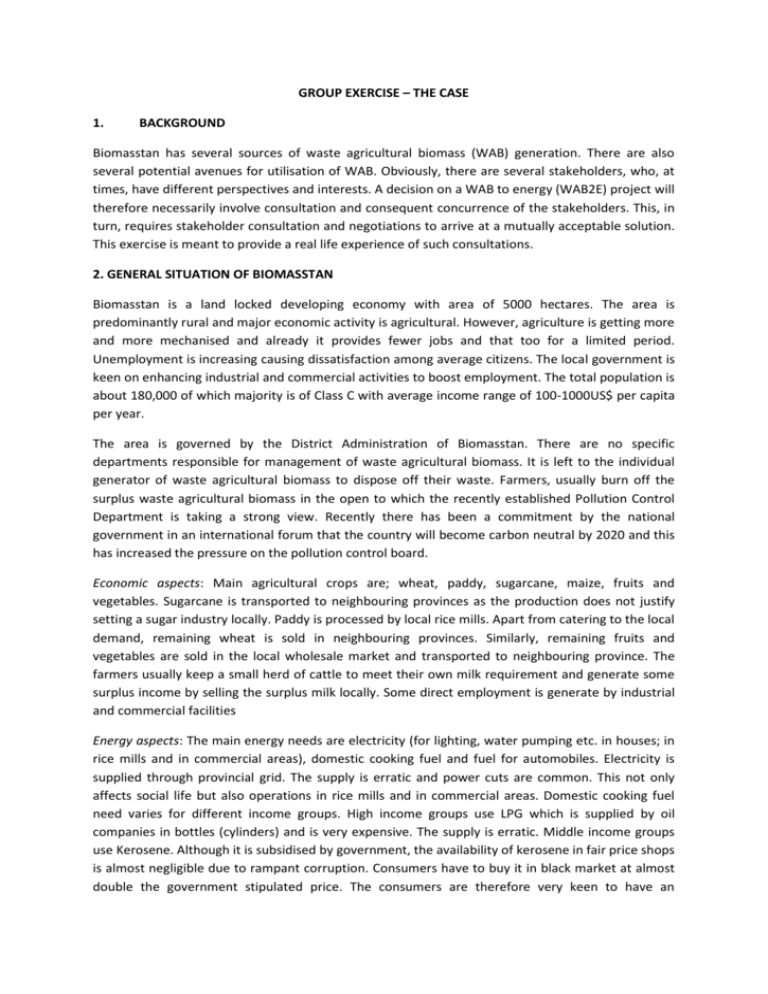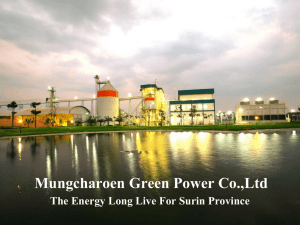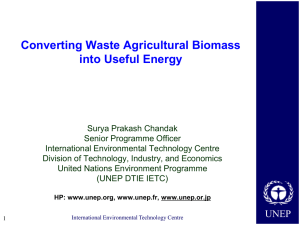10 Group Exercise the Case and Views of Stakeholders
advertisement

GROUP EXERCISE – THE CASE 1. BACKGROUND Biomasstan has several sources of waste agricultural biomass (WAB) generation. There are also several potential avenues for utilisation of WAB. Obviously, there are several stakeholders, who, at times, have different perspectives and interests. A decision on a WAB to energy (WAB2E) project will therefore necessarily involve consultation and consequent concurrence of the stakeholders. This, in turn, requires stakeholder consultation and negotiations to arrive at a mutually acceptable solution. This exercise is meant to provide a real life experience of such consultations. 2. GENERAL SITUATION OF BIOMASSTAN Biomasstan is a land locked developing economy with area of 5000 hectares. The area is predominantly rural and major economic activity is agricultural. However, agriculture is getting more and more mechanised and already it provides fewer jobs and that too for a limited period. Unemployment is increasing causing dissatisfaction among average citizens. The local government is keen on enhancing industrial and commercial activities to boost employment. The total population is about 180,000 of which majority is of Class C with average income range of 100-1000US$ per capita per year. The area is governed by the District Administration of Biomasstan. There are no specific departments responsible for management of waste agricultural biomass. It is left to the individual generator of waste agricultural biomass to dispose off their waste. Farmers, usually burn off the surplus waste agricultural biomass in the open to which the recently established Pollution Control Department is taking a strong view. Recently there has been a commitment by the national government in an international forum that the country will become carbon neutral by 2020 and this has increased the pressure on the pollution control board. Economic aspects: Main agricultural crops are; wheat, paddy, sugarcane, maize, fruits and vegetables. Sugarcane is transported to neighbouring provinces as the production does not justify setting a sugar industry locally. Paddy is processed by local rice mills. Apart from catering to the local demand, remaining wheat is sold in neighbouring provinces. Similarly, remaining fruits and vegetables are sold in the local wholesale market and transported to neighbouring province. The farmers usually keep a small herd of cattle to meet their own milk requirement and generate some surplus income by selling the surplus milk locally. Some direct employment is generate by industrial and commercial facilities Energy aspects: The main energy needs are electricity (for lighting, water pumping etc. in houses; in rice mills and in commercial areas), domestic cooking fuel and fuel for automobiles. Electricity is supplied through provincial grid. The supply is erratic and power cuts are common. This not only affects social life but also operations in rice mills and in commercial areas. Domestic cooking fuel need varies for different income groups. High income groups use LPG which is supplied by oil companies in bottles (cylinders) and is very expensive. The supply is erratic. Middle income groups use Kerosene. Although it is subsidised by government, the availability of kerosene in fair price shops is almost negligible due to rampant corruption. Consumers have to buy it in black market at almost double the government stipulated price. The consumers are therefore very keen to have an alternative, cleaner and convenient fuel. The low income group cannot afford any commercial energy and use wood (procured from a nearby forest) and crop residues. Environmental aspects: The responsibility of preserving the environment and controlling emissions and discharges lies with the Ministry of Environment. Being a predominantly agricultural area, generally the air and water quality is good. The major sources of air pollution are: emissions from transportation, emissions of fly-ash from rice mills (the rice mill owners burn the rice husk in boilers to produce steam which is used partly in rice mill operations), emission of smoke from open-burning of WAB in fields. The use of WAB as a domestic cooking fuel results in indoor air pollution and the women folk complain about respiratory diseases quite often. They also have to spend a large amount of time in drying, storage and sorting of the WAB to be used as a fuel and this leaves them with little time for rest or other social activities. The problem gets aggravated in the rainy season. Solid waste from residential, commercial and industrial waste is collected by the municipality and transported to neighbouring province for disposal in a landfill. Collection and transport of solid waste and the tipping fee levied by the landfill operator is a major drain on the municipality budget. Hence the municipality is reluctant to transport WAB (e.g. WAB from fruit and vegetable market) and the generators are required to make their own arrangement for transporting it. In absence of any formal arrangement the waste keeps on decaying in the open. Possible approach to solve the Energy and Environmental Problem: The governor of Biomasstan who lives in the centre of the district invited his close friend (who was highly educated, settled in a developed country and was in Biomasstan to visit his parents) for lunch on a Sunday. His friend was appalled to see the situation of the district and casually asked the reason for it from the governor. The governor began discussion on the various problems in Biomasstan including waste disposal, unemployment etc. during the course of lunch and both of them narrowed down that the cause of environmental problem is biomass agricultural waste and the waste from the wholesale market. The governor’s friend explained to the governor that the agricultural waste which people think is a “WASTE” is in fact a “ENERGY RESOURCE” and there are technologies and systems available to convert this into useful source of energy. His friend also told the governor that if properly implemented this will lead to social, economic and environmental sustainability of Biomasstan and has the potential of being replicated by the other districts with similar conditions. He also pointed out that since the technology was readily available in the neighbouring friendly country the cost will not be very high. The governor was highly impressed and he asked his friend to share more information about such technologies. His friend sends him the following note: Considering different types of waste agricultural biomass available in biomasstan and various applications of the fuel and/or energy that could be generated from waste agricultural biomass there could be different waste agriculture biomass to energy (WAB2E) systems and specific technologies that could be applied. 1. Technology – Briquetting WAB that can be used – All dry WAB such as straw, saw dust, plantation residues. Wet waste like vegetable residues, residues from fruit and vegetable market are not suitable. Also rice husk is difficult. Output and its possible use – Briquettes; which can be used in domestic stoves and also as a solid fuel in industrial applications Main Technical Features – Technology could range from relatively simple versions (like manual briquetting machines and low pressure briquetting machines to sophisticated version of piston type or screw type technology, easy to operate, requires electrical power to run the machine, size range very wide from a few Kg/hour to several hundred Kg/hr, high maintenance requirement particularly due to erosion of dies Main Economic Features – Low initial investment, high electrical power consumption hence high operating energy cost, moderate to low space requirement, Main Environmental Features – Generally no air emissions from the technology, cooling water may be required in some cases, relatively clean technology Main Social Features – Low-end technology like manual briquetting can have good job creation opportunity, product can provide a good domestic fuel for low income groups (particularly the torrefied version), Other Aspects – High end technology suppliers in US and Japan, several low and medium tech suppliers also in developing countries such as China and India, technology in use for several years, 2. Technology – Gasification WAB that can be used – All dry WAB such straw, saw dust, plantation residues. Wet waste like vegetable residues, residues from fruit and vegetable market are not suitable. Rice husk has been widely used for gasifiers. Output and its possible use – syn gas which is primarily a mixture of carbon mono oxide, hydrogen, methane and hydrocarbons (as combustible constituents) along with residual nitrogen, carbon dioxide and water vapour. The syn gas usually has to be cleaned to separate tarry content, and solid particles. It can be fired directly into a combustion system (e.g. a boiler), can be used in a gas engine (after proper cleaning) to generate electricity or can be converted into other fuels like methane and liquid fuels. Main Technical Features – Technology could range from relatively simple versions (like down draft fixed bed gasifiers to sophisticated versions like fluidised bed of entrained flow type, requires skilled operators, small requirement of electrical power mainly to run the air blowers, size range very wide from a few hundred Kg/day to a few tons/day, moderate maintenance requirement particularly for cleaning due to particulates and tar deposition Main Economic Features – Moderate to high initial investment depending upon type of gasifier and size of gasifier, operating cost moderately high to due gas cleaning requirements, high space requirement mainly due to gas cleaning equipment, Main Environmental Features – Generally high air emissions if proper sealing is not done, significant waste water generation from the gas cleaning (scrubbers) facilities. Main Social Features – Low job creation opportunities, the product (syn gas) usually used either for in-situ power generation or for industrial purposes. Other Aspects – High end technology suppliers in US, Europe and Japan, several low and medium tech suppliers also in developing countries such as China and India, technology in use for several years, 3. Technology – Anaerobic digestion processes WAB that can be used – All wet WAB such as waste from fruit and vegetable market and vegetable residues from farms, biodegradable household waste. Output and its possible use – Bio-gas; which is a mixture of methane, carbon di-oxide and residual air. The gas may be used as a domestic cooking fuel (very clean and convenient fuel which can even replace LPG), or in industrial combustion systems (with some modifications). After cleaning and drying it can also be used in gas engines to generate electricity. The gas generated is generally used in-situ as the cost and systems involved for compressing and bottling are very expensive. The technology also gives a valuable by-product – the digested material is a very good compost and can be fed back to the farms as a fertiliser. Main Technical Features – Technology is usually simple and has been used for years although of late some complex versions with higher gas yields have also been developed, does not require skilled operators, very small or no requirement of electrical power, size range very wide from a few Kg/day to a few hundred Kg/day, low maintenance requirement mainly for digesters and cleaning systems Main Economic Features – Low to moderate initial investment depending upon type of digester and extent of cleaning/drying system, low operating cost , moderate space requirement depends on type of technology – digesters can be built underground however, gas holders requires space, Main Environmental Features – No air emissions from the technology, relatively clean technology, sometimes there may be odour problem Views of stakeholders 1. Farmers – have a problem of disposal of WAB, burning in the open is being objected by residents due to smoke problems. , amount (about 20% -- mainly wheat straw) is used as animal feed. Some farmers use WAB as fuel in kitchen which causes indoor pollution and frequent complaints from the women folk. They are very keen to have someone take away their WAB and will prefer to have a better fuel for use in household kitchen. A large remaining amount of WAB is allowed to rot in the field hoping that it will provide some fertiliser. The farmers also run a cooperative wholesale fruit and vegetable and fruit market. The cooperative incurs a huge cost in disposing WAB as local municipality does not pick it up and they have to transport it themselves to the landfill, very keen to have reliable electricity supply but cannot afford running of diesel generators, WAB has to be disposed of daily as it is highly putrescible and cause odour problem. The farmers’ first preference is to have a technology with which they can produce cleaner fuel (like briquettes) for domestic use. They would also be interested in a technology to treat the waste from wholesale fruit and vegetable market. 2. Rice mill owners -- business is doing good, have surplus rice husk even after meeting their own fuel needs, aware of the fact that current pattern of rice husk combustion is very inefficient and a better fuel will improve their thermal efficiency and also their profitability, rice husk being very voluminous the storage requires huge space, face complaints from residents of flying air-borne rice husk, have received closure notices from pollution control authorities for excessive emission of fly ash from their boilers and paddy dryers, keen to dispose of surplus rice husk. They would like to have a technology which can use rice husk to generate electricity (such as gasification followed by either a steam turbine cycle or a gasifier syn gas fired generator) and the electricity is given free to them. 3. Representatives of citizens – Very upset with open burning of WAB by large farmers and menace of rice husk and fly ash from rice mills, also occasional complaints for odour from wholesale fruit and vegetable market, very concerned about scarce availability of kerosene, very keen to have a clean domestic cooking fuel – will prefer to have gas/liquid fuel but can also accept solid fuel as long as it is cheap and burns without smoke. Concern about the health aspects of the women. They are open to all technologies provided the energy generated (or fuel produced) is made available at very low prices. 4. Representative of Ministry of Environment – generally in support of WAB2E project provided the emissions and discharges are within stipulated standards, has not been able to resolve the issues of fly ash emissions from rice mills since mills cannot afford to install expensive bag filters and he cannot order their closure due to political pressure, is also concerned with open burning as it causes severe smog in winters. Have funds to subsidise the clean technology projects. They are not in favour of rice husk based conversion systems unless full air pollution control systems are provided. They will prefer to have a technology which can use WAB from farms. 5. Manager, Bank of Biomasstan – quite keen on extending loans for economically viable projects in biomasstan, sees WAB2E project as an interesting project but is largely unaware of the details as he does not experience of financing such projects, will therefore like to examine everything in detail and move cautiously. He will be interested in a capital intensive technology so that the loan requirement of the entrepreneur is high. He would therefore prefer rice husk gasification with steam turbine cycle and not the syn gas fired gasifier system as the latter is reported to have operational problems due to tar. 6. Entrepreneur of Climate Neutral WAB2E Project – Probably has the highest interest and sees it as an excellent business opportunity, wants an early approval of the project, has already identified the technology but does not want to disclose it due to competition threats, does not have adequate funds for investment and will have look for subsidy from MOE and loan from bank 7.Governor – Wants to increase the industrial and commercial employment opportunities, is keen on establishing new industries and thus a supporter of WAB2E project, is seized of the problems caused by unreliable electricity supply and black market in kerosene and will therefore like to augment local sources of energy. He would like to have a technology which can provide highest level of employment for unskilled persons. Annexure How did you perform? Finally, make a self-assessment of how did you perform. What did you, as a particular stakeholder, wanted to achieve and how well did you achieve it. How important you think was your role in the WAB2E Project? S. No. 1. 2. 3. 4. What did you want to achieve (list at least 3 and maximum 5) How well did you achieve your targets (Either give a quantitative achievement e.g. secured $100,000 commitment for the project, or rate your achievement on a scale of 0 to 10 with 10 being 100% achievement How did you achieve your target – brief description of strategies adopted Why you could not achieve your targets – brief description of where and why you failed 5. Finally, your overall impression about the exercise: __________________________________________________________________________________








